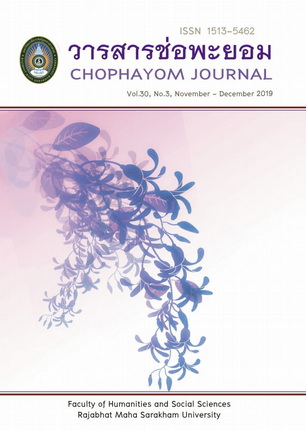Development of English Speaking Ability Baedsed on Communicative Language Teaching (CLT): Case Study in a Language Center
Keywords:
Development, English Speaking Ability, Communicative Language Teaching (CLT), Language CenterAbstract
The purposes of this research were (1) to investigate the situations in implementing CLT, (2) to examine the students’ English speaking skill development through CLT lessons, and (3) to investigate the attitudes of the teachers and the students toward CLT lessons after studying through CLT lessons. This research consisted of three phases: investigating the situations, analyzing the students’ English speaking development, and investigating the attitudes of the teachers and the students after studying through CLT lessons, using quantitative and qualitative methods. The participants were 4 teachers and 27 students (four classrooms) in Phase 1 and 4 teachers and 7 students (one classroom) in Phase 2 and 3. The research instruments were the questionnaires, the interview questions, the five CLT lessons, and the assessment form. The data obtained were analyzed by using Mean, Standard Deviation and t-test. The findings of the research revealed that
(1) the teachers and the students had positive attitudes toward CLT. Both the teachers and the students acknowledged their roles in CLT. The main problems that impeded the teachers from implementing CLT were their lack of English exposure, the students’ lack of English speaking skills and too many students in the classroom. The major factors that caused the problems in English speaking of the students were their lack of English speaking skills and English exposure. (2) After studying through the CLT lessons, the students’ English speaking skills were significantly higher, significant at the .05 level. The students had significantly higher mean scores on the post-test (M=28.83, S.D=2.12) than the pre-test (M=19.06, S.D=2.91). (3) The findings also showed that the attitudes of the teachers and the students toward CLT lessons were positive after studying and teaching through CLT lessons. Keywords : Development, English Speaking Ability, Communicative Language Teaching (CLT), Language Center
References
2.English Language Institute, Office of the Basic Education Commission, Ministry of Education. (2015). CEFR Manual for Primary Level2. Retrieved November 25, 2017, from https://english.obec.go.th/english/2013/index.php/th/2012-08-08-10-26-5/74-cefr, p. 1-171.
3.Jafari, S. M., Shokrpour, N., & Guetterman, T. (2015). A Mixed Methods Study of Teachers' Perceptions of Communicative Language Teaching in Iranian High Schools. Theory and Practice in Language Studies, 707-718.
4.Karavas-Doukas, E. (1996). Using attitude scales to investigate teachers’ attitude to the communicative approach. EFL Journal, 50(3), 187-198.
5.Nanthaboot, P. (2012). Using Communicative Activities to Develop English Speaking Ability of Matthayomsuksa Three Students. Unpublished master's thesis, Srinakharinwirot University.
6.Noom-ura, S. (2013). English-Teaching Problems in Thailand and Thai teachers' Professional Development Needs. English Language Teaching, 139-147.
7.Ozsevik, Z. (2010). The Use of Communicative Language Teaching (CLT): Turkish EFL Teachers' perceived difficulties in Implementing CLT in Turkey. Master's thesis, University of Illinois.
8.Richards, J. C. (2006). Communicative Language Teaching Today. New York: Cambridge University Press.
9.Savignon, S. J., & Wang, C. (2003). Communicative Language Teaching in EFL context: Learner Attitudes and Perception. International Review of Applied Linguistics in Language Teaching, 223-249.
10.Taebi, I., Torabi, Z., & Farsani, A. M. (2016). Depicting EFL Learners' and Teachers' Perceptions toward Communicative Language Teaching: Voices from Iran. Iranian EFL Journal, 28-53.






